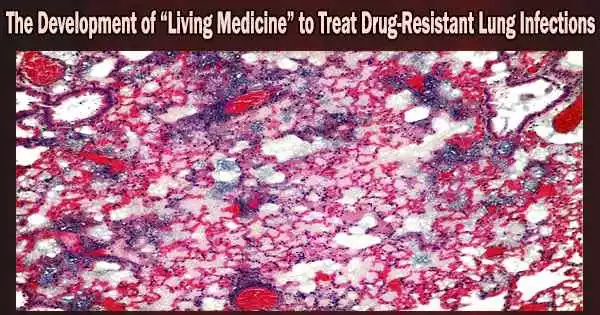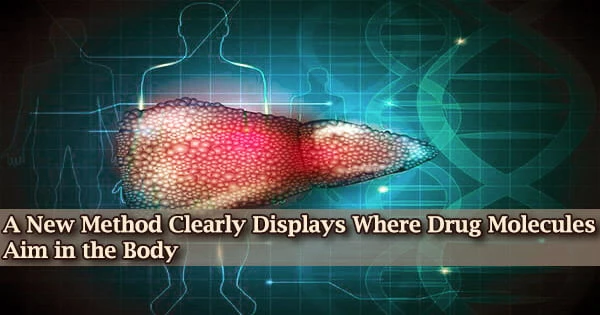Living Medicine is a new approach to treating lung infections that are resistant to traditional drugs. It involves using living organisms, such as bacteria or fungi, to deliver therapeutic compounds directly to infected lung tissues.
Researchers have designed the first ‘living medicine’ to treat lung infections. A prevalent cause of infections in hospitals, Pseudomonas aeruginosa is a form of bacteria that is naturally resistant to many different types of antibiotics.
The treatment involves using a modified version of the bacterium Mycoplasma pneumoniae, removing its ability to cause disease and repurposing it to attack P. aeruginosa instead. Low doses of antibiotics that wouldn’t ordinarily be effective alone are combined with the transformed bacterium.
Researchers examined the treatment’s effectiveness in mice and discovered that it greatly decreased lung infections. Comparing the mouse survival rate with no therapy, the ‘living medicine’ doubled it.
No toxicity was visible in the lungs following the administration of a single, high dose of the medication. The transformed bacteria were eradicated by the innate immune system four days after the course of treatment was complete.
The findings are published in the journal Nature Biotechnology and are supported by the “la Caixa” Foundation through the CaixaResearch Health call. The study was led by researchers at the Centre for Genomic Regulation (CRG) and Pulmobiotics in collaboration with the Institut d’Investigacions Biomèdiques August Pi i Sunyer (IDIBAPS), Hospital Clinic de Barcelona and the Institute of Agrobiotechnology (IdAB), a joint research institute of Spain’s CSIC and the government of Navarre.
P. aeruginosa infections are difficult to treat because the bacteria lives in communities that form biofilms. Biofilms are impermeable formations that can grow on a variety of bodily surfaces and resist antibiotic treatment.
P. aeruginosa biofilms can grow on the surface of endotracheal tubes used by critically-ill patients who require mechanical ventilators to breathe. This causes ventilator-associated pneumonia (VAP), a condition which affects one in four (9-27%) patients who require intubation. The incidence exceeds 50% for patients intubated because of severe Covid-19. VAP can cause an intensive care unit stay to be extended by up to thirteen days and can be fatal for up to one in eight patients (9–13%).
Live biotherapeutics such as M. pneumoniae provide ideal vehicles to help overcome the traditional limitations of cytokines and unlock their huge potential in treating a variety of human diseases. Engineering cytokines as therapeutic molecules was critical to tackle inflammation. Other lung diseases such as asthma or pulmonary fibrosis could also stand to benefit from this approach.
Dr. Ariadna Montero Blay
The authors of the study engineered M. pneumoniae to dissolve biofilms by equipping it with the ability to produce various molecules including pyocins, toxins naturally produced by bacteria to kill or inhibit the growth Pseudomonas bacterial strains.
To test its efficacy, they collected P. aeruginosa biofilms from the endotracheal tubes of patients in intensive care units. They discovered that the therapy broke through the barrier and effectively removed the biofilms.
“We have developed a battering ram that lays siege to antibiotic-resistant bacteria. The treatment punches holes in their cell walls, providing crucial entry points for antibiotics to invade and clear infections at their source. We believe this is a promising new strategy to address the leading cause of mortality in hospitals,” says Dr. María Lluch, Chief Scientific Officer at Pulmobiotics, co-corresponding author of the study and principal investigator at the International University of Catalonia.
Before beginning the clinical trial phase, the researchers will conduct more studies with the goal of using the ‘living medicine’ to treat VAP. A nebulizer, a machine that transforms liquid medication into a mist that is then inhaled through a mouthpiece or a mask, will likely be used to provide the treatment.
M. pneumoniae is one of the smallest known species of bacteria. Dr. Luis Serrano, Director of the CRG, first had the idea to modify the bacteria and use it as a ‘living medicine’ two decades ago.
Dr. Serrano is a specialist in synthetic biology, a field that involves repurposing organisms and engineering them to have new, useful abilities. With just 684 genes and no cell wall, the relative simplicity of M. pneumoniae makes it ideal for engineering biology for specific applications.
The fact that M. pneumoniae is natively suited to lung tissue is one benefit of employing it to treat respiratory disorders. The modified bacterium is administered and immediately travels to the respiratory infection site, where it sets up shop like a temporary factory and manufactures a range of medicinal chemicals.
The discovery opens the way for researchers to develop new strains of M. pneumoniae to combat various forms of respiratory disorders including lung cancer or asthma by demonstrating that the bacterium can treat lung infections.
“The bacterium can be modified with a variety of different payloads whether these are cytokines, nanobodies or defensins. The aim is to diversify the modified bacterium’s arsenal and unlock its full potential in treating a variety of complex diseases,” says ICREA Research Professor Dr. Luis Serrano.
In addition to designing the ‘living medicine’, Dr. Serrano’s research team are also using their expertise in synthetic biology to design new proteins that can be delivered by M. pneumoniae. The team are using these proteins to target inflammation caused by P. aeruginosa infections.
Although inflammation is the body’s normal response to an infection, it can harm lung tissue if it is high or continues for an extended period of time. The immune system controls the inflammatory response by releasing mediator proteins like cytokines. One type of cytokine IL-10 has well-known anti-inflammatory properties and is of growing therapeutic interest.
Research published in the journal Molecular Systems Biology by Dr. Serrano’s research group used protein-design softwares ModelX and FoldX to engineer new versions of IL-10 purposefully optimised to treat inflammation. The cytokines were designed to be created more efficiently and to have higher affinity, meaning less cytokines are needed to have the same effect.
The researchers engineered strains of M. pneumoniae that expressed the new cytokines and tested its efficacy in the lungs of mice with acute P. aeruginosa infections. They found that engineered versions of IL-10 were significantly more effective at reducing inflammation compared to the wild type IL-10 cytokine.
According to Dr. Ariadna Montero Blay, co-corresponding author of the study in Molecular Systems Biology, “live biotherapeutics such as M. pneumoniae provide ideal vehicles to help overcome the traditional limitations of cytokines and unlock their huge potential in treating a variety of human diseases. Engineering cytokines as therapeutic molecules was critical to tackle inflammation. Other lung diseases such as asthma or pulmonary fibrosis could also stand to benefit from this approach.”
















